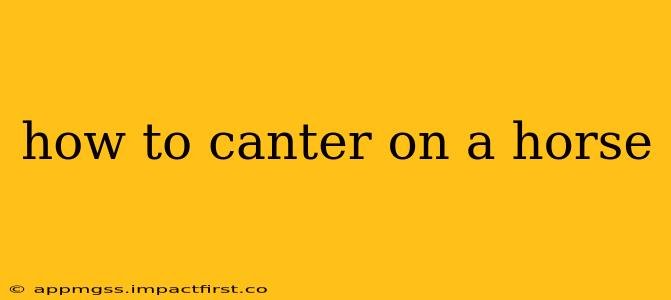Cantering is a thrilling and elegant gait, a natural progression for any rider beyond the walk and trot. This guide will break down the process, addressing common questions and offering tips for a smooth and confident canter. Whether you're a beginner taking your first steps or a more experienced rider looking to refine your technique, this comprehensive guide will help you master this beautiful three-beat gait.
What are the Different Types of Canters?
There are two main types of canters: the right lead canter and the left lead canter. The "lead" refers to the leading foreleg; in a right lead canter, the right foreleg leads, and vice versa. Understanding and correctly using the appropriate lead is crucial for balance and efficiency. Incorrect leads can lead to discomfort for both horse and rider, and potentially even falls. Learning to recognize and control your horse's lead is a vital skill.
How Do I Ask My Horse to Canter?
The specific cues used to initiate a canter vary depending on the horse's training and the rider's preferred method. However, common techniques involve:
- Using your seat and legs: A subtle shift in your weight, combined with a slight increase in leg pressure, can encourage your horse to transition to a canter. The timing and pressure will need to be adjusted depending on your horse's responsiveness.
- Using your reins: While not the primary cue, gentle rein aids can help guide and support your horse as it transitions to the canter. Avoid pulling on the reins; instead, use them for subtle guidance.
- Voice commands: Some riders use voice commands like "canter" or "lope" to signal the desired gait transition. This often works best in conjunction with other cues.
The key is to be consistent and clear in your aids. Your horse needs to learn to associate your cues with the desired action. Practice makes perfect!
How Do I Stay Balanced While Cantering?
Maintaining balance during the canter requires a combination of correct posture, seat, and leg position.
- Posture: Sit tall with your shoulders relaxed, your core engaged, and your weight evenly distributed in your seat.
- Seat: Follow the horse's motion, allowing your body to rise and fall gently with the rhythm of the canter. Avoid gripping with your legs or clenching your muscles.
- Leg position: Keep your legs in contact with the horse, using them for support and balance but not gripping tightly.
Practicing your canter in a secure environment, such as an arena, is recommended, especially when you are learning.
What if My Horse Doesn't Respond to My Canter Cue?
If your horse isn't responding, consider the following:
- Clarity of your aids: Are you giving clear and consistent cues?
- Horse's fitness and readiness: Is your horse tired or otherwise not fully prepared for the canter?
- Training level: Has your horse been properly trained in the canter transition?
- Rider's position: Is your posture and balance affecting the horse's ability to understand your cues?
If you're struggling, seeking guidance from a qualified instructor is highly recommended. They can assess your technique and your horse's training level and offer personalized advice.
How Do I Stop Cantering?
To smoothly transition out of a canter, usually into a trot, and then to a walk, use a gentle increase in rein contact while maintaining your seat and leg position. This will help your horse slow its pace and transition to a trot. Then, follow your usual cues for transitioning from a trot to a walk. A gradual, controlled stop is always safer than an abrupt one.
What are Common Canter Mistakes to Avoid?
- Leaning forward or backward: Maintaining a balanced and centered posture is crucial for both safety and control.
- Gripping with your knees or thighs: This restricts the horse's movement and can lead to discomfort.
- Pulling on the reins: Instead of pulling, use gentle pressure to guide your horse.
- Ignoring your horse's signals: Pay attention to your horse's body language for signs of discomfort or reluctance.
Remember, patience and consistency are key. With practice and guidance from a qualified instructor, you will improve your canter and build a strong partnership with your horse.
